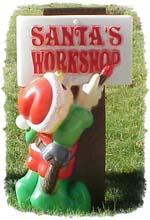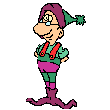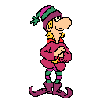Magic Elves are adorable Christmas characters who fly at the speed of Santa’s reindeer and the light of Rudolph’s nose. Around the first of December each year, Santa and Mrs. Claus send these helpers from the North Pole to boys and girls homes throughout the world. Sometimes, if needed, an elf may appear as early as Thanksgiving. Each Elf observes its children during the holiday months to see who is being naughty and who is nice.
Shortly before Christmas Eve, as Santa prepares to pack his sleigh, the Magical Elves return to the enchanted, snowy north to make their reports as
jolly Old St. Nicholas checks his list not once, but twice before filling his bag with toys, presents, and Christmas cheer. Of course, Kris Kringle also packs lumps of coal to put in the Christmas stockings as needed.
Elves, in Germanic folklore, originally, a spirit of any kind, later specialized into a diminutive creature, usually in tiny human form. In the Prose, or Younger, Edda, elves were classified as light elves (who were fair) and dark elves (who were darker than pitch); these classifications are roughly equivalent to the Scottish seelie court and unseelie court. The notable characteristics of elves were mischief and volatility. They were believed at various times and in various regions to cause diseases in humans and cattle, to sit upon the breast of a sleeper and give him bad dreams (the German word for nightmare is Alpdrücken, or “elf-pressure”), and to steal human children and substitute changelings (deformed or weak elf or fairy children). In the British Isles, flint implements called elf-bolts, elf-arrows, or elf-shot (which are now known to be prehistoric tools used by the aboriginal Irish and the early Scots) were believed to be the weapons with which elves injured cattle. Elves occasionally also were benevolent and helpful. The second edition of Encyclopædia Britannica, which was published in 1777–84, calls the word elf obsolete but reports that belief in such creatures “still subsists in many parts of our own country. . . In the Highlands of Scotland, new-born children are watched till the christening is over, lest they should be stolen or changed by some of these phantastical existences.” In time, elves came to be indistinct from fairies, though both older classics—such as Johann Wolfgang von Goethe's poem “Der Erlkönig” (“The Elf King”)—and such modern classics as J.R.R. Tolkien's Lord of the Rings (1954–55) still treat elves as a distinct type.



